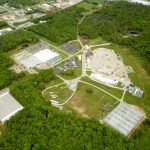Representative Zepnick: Again Proposes Ideas and Invites Discussion on New Milwaukee Bucks Arena
Rep Zepnick Says No to Old Boys Club Deciding New Arena Plan
Representative Josh Zepnick South Side (D–Milwaukee) today, called for a smarter and more transparent discussion about the future of a Bucks Arena, noting that the public support for raising taxes is slim to none and the economic spillover of either an NBA team itself or a downtown arena are being grossly exaggerated by the business community, City Hall, and other proponents of a new arena.
“It is clear to me and I have been able to confirm, that the discussion over locating and financing a new Arena is being held behind closed doors and with only a few voices at the table in terms of location, financing options, and the economic impact of the Bucks. This kind of good old boys club approach is exactly the process that the public abhors and resembles the worst of the worst when it comes to building sports facilities. Secrecy helped fog the entire debate over the Brewers stadium and left collateral damage all over the city and state” Zepnick stated.
Fresh off his visit to the Twin Cities where the National Conference of State Legislators was held, Zepnick added that Minneapolis has lessons to learn from and provides a great example of urban renewal that has a much broader definition of “Downtown” and its amenities.
“When it comes to this fuzzy proposal from City Hall about linking a taxpayer subsidized “entertainment district” to a new Arena, I urge Milwaukee officials to examine the “Block E” project in Downtown Minneapolis, a short walk from the main shopping district and next to the Timberwolves Arena. After 10 years of planning and debate and over $50 in taxpayer subsidies, the entire block is boarded up and nearly all tenants, including a 15 screen movie theater are gone forever. The next stage is apparently to use the space for Timberwolves practices and the Mayo Clinic is locating some offices there. Not exactly what I would call a transformative effort to bring people downtown. Having said that, the Minneapolis downtown is thriving and it’s not because they locate their Convention Center, Arenas, or retail corridor right next to each other. In fact, all those public facilities are blocks and blocks apart from each other, with successful housing, dining, entertainment, and shopping interspersed through good old fashioned private sector investment,” Zepnick remarked.
“Using transit, improved sidewalk and skywalk infrastructure, as well as signage, lighting, and landscaping it would be very easy as well as cost-effective to tie together the vast and opportunity filled west side of Downtown Milwaukee going as far west as the Potawatomi Hotel and Casino, Marquette University, the existing Convention Center and UWM Arena, and points north where Pabst and Park East sit. Why this is not seen as a cohesive part of Downtown Milwaukee continues to boggle my mind,” said Zepnick.
Because of a poor location choice by the City of Milwaukee, Zepnick’s original proposal to tear down and rebuild the site at Keep Greater Milwaukee Beautiful on 13th street will not be possible.
Instead, Zepnick proposes to locate the Arena on land west of the 16th Viaduct and relocate the Marquette soccer field. The same links that were in the original proposal would continue to be positive factors: near Interstate, access to Amtrak and transit, proximity to Marquette fans when they play in the new Arena, neighboring Casino and Hotel for tourists/visitors, and under-utilized land that is not paying taxes, including multiple City DPW garages and parking lots and other open land.
Importantly, Zepnick pointed out that “with the departure of the Cargill meatpacking plant at 1915 Canal Street, there is a huge opportunity to connect these initiatives that helps to transform the east side of the Valley as well as pay for a new Arena without raising taxes, creating new jobs in the Valley and Downtown’s west side.”
Zepnick challenged the notion that NBA players “income tax diversion” is an acceptable method to subsidize a new arena. “For starters, I have questions about whether a bond investment shop would count that as steady cash flow for paying back the borrowed money. What if the NBA shuts down again? What if other variables create shortfalls who, is on the hook? Milwaukee taxpayers come to mind first and foremost.
Furthermore, Zepnick noted that economic studies on new sports facilities often use shabby math and economics: should one form of consumer spending (i.e. going to a Bucks game), it is not like those dollars disappear from Milwaukee. In fact, they simply get diverted to other entertainment or discretionary spending. And, if that spending is not at locations subsidized by taxpayers, its actually an increase in overall economic growth.
Zepnick also finds it disturbing that the new owner’s contribution is being sold to the community as some sort of free gift. “Set aside the obvious need to match that contribution with taxpayer dollars, aren’t the new owners some of the biggest beneficiaries of a new Arena and the dollars that trickle in? When you combine the owner’s return on investment expectations along with NBA demands, there is a serious issue to address about building a self-contained destination that instead of generating spillover spending, it sucks it into the Arena during games. This is where the math gets slippery, because you could have neighboring restaurants, bars paying taxes to compete with an entity that is removing their customers.”
Zepnick’s original proposal contained 7 key priorities that should be part of the larger and more inclusive community discussion on this project:
- Avoid the current footprint of Bradley Center and tear down.
- Insist the Wisconsin Center district is at the table so that Convention and hotel space can be expanded in near future.
- No sales tax increase.
- No diversion from the general fund, known as a Super TIF.
- Project Workforce agreement to have Union labor build the new facility, with an emphasis to hire Milwaukee’s unemployed and minority citizens.
- Build off links to Interstate system and Public Transit.
- Set-aside portion of future arena revenue stream to Milwaukee parks and recreation facility upgrades and maintenance for youth, public use.
Zepnick is also calling on the City Comptroller’s office to examine the Bradley Center’s finances, review the income tax revenue of NBA players and related employees and its impact on Milwaukee’s spending.
NOTE: This press release was submitted to Urban Milwaukee and was not written by an Urban Milwaukee writer. While it is believed to be reliable, Urban Milwaukee does not guarantee its accuracy or completeness.
Mentioned in This Press Release
Recent Press Releases by Josh Zepnick
Josh Zepnick announces candidacy for 13th District alderman
Jun 28th, 2019 by Josh Zepnick“Too many South Side residents feel that the new economic investment either goes to really poor areas or already wealthy areas, with the middle ground often left paying more and more in taxes and fees.”























